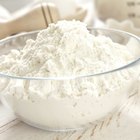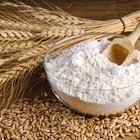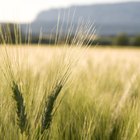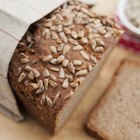
Flour serves as the base ingredient and the starting point in all baked goods. Milled from a variety of different grains, the types of flour used in everyday baking are generally obtained from wheat. Many recipes, especially in bread-baking, call for whole-wheat, rye, buckwheat or spelt flour, alone or combined with white flour. But unless a recipe specifies a different type, you should use a wheat-based white flour for all your baking.
Types of Flour
All flour is graded in part by its protein content, and grocery store shelves typically feature only a few types. The most basic of them is all-purpose, which, as its name implies, can be used in any type of baked good. All-purpose flour is composed of soft and hard wheat flours and can be bleached or unbleached. Either type can be used interchangeably in baking. Cake and pastry flours produce the more delicate texture seen in white cakes and biscuits, while bread flour, made from hard wheat, has the high gluten content necessary to the rising process. Self-rising flour contains baking powder and salt, but has a shorter shelf life as the baking powder can loses its strength if stored too long.
Function
Used in baking, flour holds ingredients together, resulting in batter or dough. The strength and texture of baked goods result from the gluten that develops when the protein in flour is combined with moisture and heat. Because the amount of protein varies in different flours, you should try as much as possible to use the type called for in the recipe to assure the best results. For example, if you use all-purpose flour in a recipe that calls for cake flour, the finished cake won't be as light or tender.
Baking
As the most basic ingredient in cakes, cookies, breads and pie crusts, flour is often the first dry ingredient listed in recipes. Unless otherwise specified, all other dry ingredients such as baking powder, baking soda, salt and any dry spices such as cinnamon are combined with the flour before wet ingredients are added. Flour can be measured out by the dip-level-pour method, which involves fluffing the flour with a knife and scooping the required amount out with a dry measuring cup. You then level the excess flour off with your hand or a knife before adding it to the recipe. For cakes and other more delicate pastries, you can sift the flour with the other dry ingredients, which aerates it. If in doubt, adhere strictly to the recipe's instructions, as it has been developed around the proper way to bake a particular item.
Other Uses
Many recipes for baked goods call for greasing and dusting the baking pan or pans. After lightly greasing the pan with solid shortening, a light dusting of flour is sprinkled in and distributed by tapping and tipping the pan on all sides. Flour is also used as a coating, plain or combined with seasonings, for oven-baked chicken or fish. When kneading bread or rolling out and cutting pie crust or cookie dough, flour is invaluable for keeping the dough or crust from sticking to hands, rolling pin, cookie cutter or counter.
Related Articles

Do You Still Need Baking Powder & Salt ...

How to Use Millet Flour
Should Cake Flour Be Sifted Before ...
Is Unbleached Flour the Same as ...
What Kind of Flour Do You Use for a ...

What Kind of Oil Do You Use in Brownie ...

What Kind of Flour to Use for Cupcakes?

Differences Between Bleached Flour & ...

If Flour Has Never Been Opened Can It ...
What Is the Difference Between Cake ...

What Are Ingredients in Wheat Bread?
Does Cake Flour Contain Baking Soda & ...

Whole Wheat Pastry: Flour Substitutions

Can You Substitute Whole Wheat Pastry ...
Can You Substitute Whole-Wheat Pastry ...

Substitute for Gram or Besan Flour

How to Substitute Cornstarch for ...

Russian Rye Bread vs. Pumpernickel

What Is a Substitute for Potassium ...
Why Do My Biscuits Turn Out Hard and ...
References
Writer Bio
Rachel Lovejoy has been writing professionally since 1990 and currently writes a weekly column entitled "From the Urban Wilderness" for the Journal Tribune in Biddeford, Maine, as well as short novellas for Amazon Kindle. Lovejoy graduated from the University of Southern Maine in 1996 with a Bachelor of Arts in English.
Photo Credits
Hemera Technologies/PhotoObjects.net/Getty Images